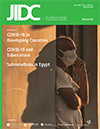Blackleg in inadequately immunized calves and their recovery following antibiotic therapy
DOI:
https://doi.org/10.3855/jidc.12613Keywords:
Clostridium chauvoei, cattle disease, clostridial disease, blackleg, immunizationAbstract
Introduction: There is consensus regarding the importance of blackleg vaccination as a preventive measure, and proper immunization protocols are available. However, few studies have evaluated the effectiveness of vaccine protection against Clostridium chauvoei and the treatment of the disease in calves exhibiting early or advanced clinical courses. This study describes twelve blackleg cases in unvaccinated calves and in calves that received a single dose of the vaccine. It also reports the recovery of some calves after antibiotic therapy.
Methodology: Two necropsies of cattle dead from blackleg were performed. Fragments of skeletal muscle from these two cattle were immersed in paraffin for multiplex polymerase chain reaction (PCR) analysis.
Results: Twelve calves up to nine months of age developed signs of blackleg and eight died. Ten of those 9-month-old calves had received only the first dose of a blackleg vaccine at 4 months of age, but no booster. The last two affected calves belonged to a herd that had never been vaccinated. Four out of five calves treated with penicillin for 6-7 days recovered from the disease. The diagnosis of blackleg was based on necropsy, histopathological findings and detection of C. chauvoei in skeletal muscle samples of two necropsied calves using PCR.
Conclusions: The occurrence of cases only in calves that did not receive a booster dose or were not vaccinated indicated that the vaccine used was effective when performed as recommended by the manufacturer. However, neglecting the booster resulted in casualties due to blackleg.
Downloads
Published
How to Cite
Issue
Section
License
Authors who publish with this journal agree to the following terms:
- Authors retain copyright and grant the journal right of first publication with the work simultaneously licensed under a Creative Commons Attribution License that allows others to share the work with an acknowledgement of the work's authorship and initial publication in this journal.
- Authors are able to enter into separate, additional contractual arrangements for the non-exclusive distribution of the journal's published version of the work (e.g., post it to an institutional repository or publish it in a book), with an acknowledgement of its initial publication in this journal.
- Authors are permitted and encouraged to post their work online (e.g., in institutional repositories or on their website) prior to and during the submission process, as it can lead to productive exchanges, as well as earlier and greater citation of published work (See The Effect of Open Access).








